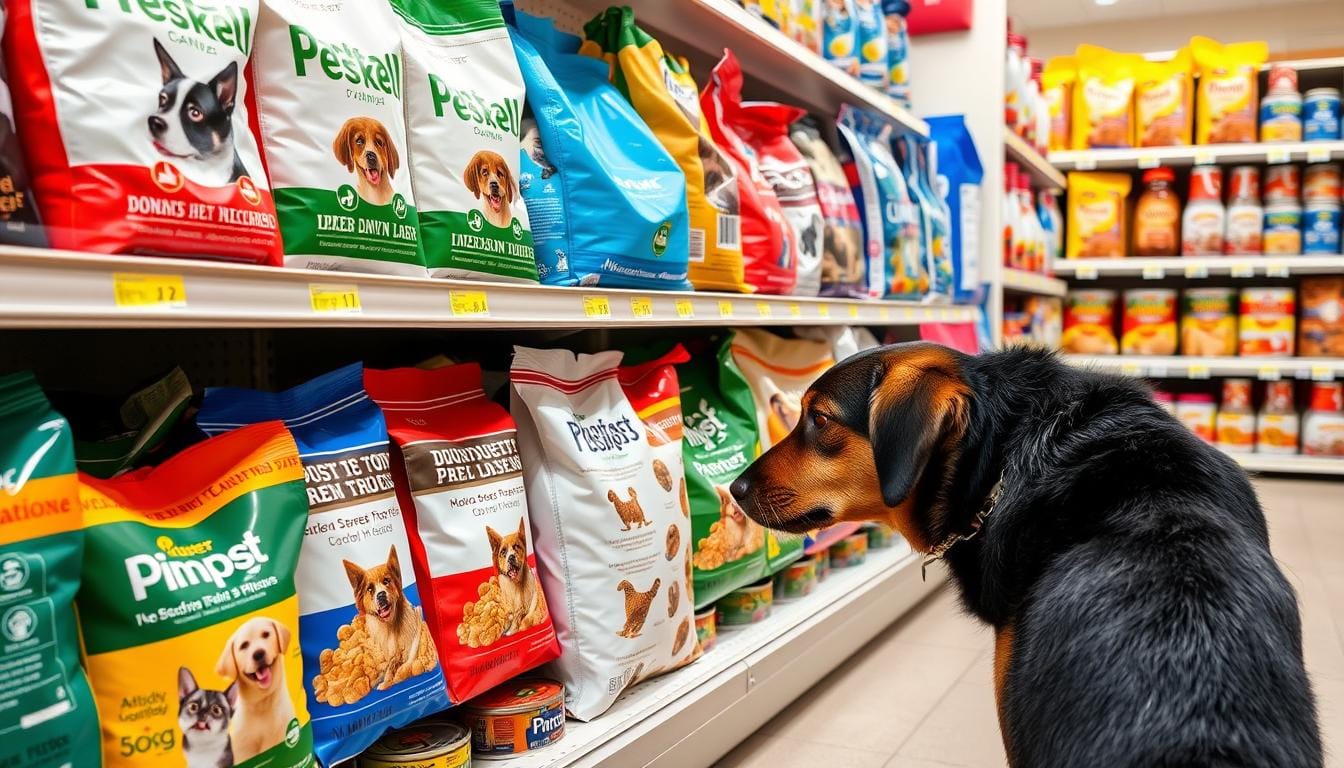Finding the right food can change your dog’s life. Let’s explore what’s best for them together! Choosing dog food is a big decision for pet owners. With so many options, it can feel overwhelming. We’re here to guide you through dog nutrition and help you choose the right food for your furry friend.
Dog food comes in many forms, each for different needs. From puppy to senior formulas, knowing these options is important for your dog’s health. We’ll cover the basics of dog nutrition, explain food labels, and look at age and breed size.
Did you know that at least 70% of a product must be beef if it just says “beef”? Or that “with beef” only needs 3% beef content? These details show how complex choosing the right food for your dog can be. We’ll go into these points and more, giving you the knowledge to pick the best food for your pet’s health.
Key Takeaways
- Understanding dog nutrition basics is crucial for selecting the right food
- Different life stages require specific nutritional considerations
- Breed size can influence dietary needs
- Decoding food labels helps in making informed choices
- Consult with a veterinarian for personalized dietary advice
- Gradually transition between different dog foods to prevent digestive issues
Understanding Dog Nutrition Basics
A balanced diet is key to a dog’s health. We’ll look at what dogs need to stay healthy. This will help you choose the best food for your pet.
Essential Nutrients for Dogs
Dogs need six main nutrients: water, proteins, fats, carbs, minerals, and vitamins. These nutrients keep dogs healthy and full of energy. The Association of American Feed Control Officials (AAFCO) makes sure pet foods meet these needs.
Protein Requirements for Different Life Stages
Protein is vital for growth and upkeep. Puppies need at least 22% protein, while adults need 18%. But, don’t give dogs more than 30% protein. The quality of protein is also important, measured by its Biological Value (BV).
The Role of Fats and Carbohydrates
Fats give dogs 2.25 times more energy than proteins or carbs. They also help with inflammation and skin health. Carbs give energy and fiber. Dogs can eat both plants and animals.
| Nutrient | Function | Recommended Amount |
|---|---|---|
| Protein | Growth and maintenance | 18-30% (varies by life stage) |
| Fats | Energy, skin health | 5-20% (depends on activity level) |
| Carbohydrates | Energy, digestive health | 20-50% (varies by diet type) |
Keep in mind, these are general guidelines. Your dog’s needs can change based on age, breed, and health. Always talk to a vet to find the best diet for your dog.
Types of Commercial Dog Food
We have many options for our furry friends’ food. High-quality dog food brands offer different types for various needs and preferences. Let’s look at the main categories of commercial dog food available.

Dry kibble is the most popular and affordable choice. It’s easy to store, helps with dental health, and comes in big bags. Dry food is packed with nutrients and lasts a long time, making it a great choice for many.
Wet food, found in cans, has more moisture. This can help dogs who need more water. It’s pricier than dry kibble but tastes better and is good for dogs with dental problems.
Semi-moist dog food has more moisture than dry food but less than wet food. It’s easy to serve but may have more artificial preservatives and sugars. This makes it less ideal for regular meals.
| Type | Moisture Content | Cost | Convenience |
|---|---|---|---|
| Dry Kibble | 10-12% | Low | High |
| Wet Food | 75-78% | High | Medium |
| Semi-Moist | 25-35% | Medium | High |
When picking a type, think about your dog’s age, size, health, and likes. Always talk to a vet to find the best food for your pet’s needs.
Decoding Dog Food Labels
Reading dog food labels can be tricky, but it’s crucial for your pup’s health. Let’s break down the key elements to look for when choosing the right food for your furry friend.
AAFCO Guidelines and Standards
The Association of American Feed Control Officials (AAFCO) sets important rules for dog food labeling. For example, the 95% Rule states that products named “Chicken for Dogs” must contain at least 95% chicken. The 25% Rule applies to names like “Beef Dinner for Dogs,” requiring at least 25% of the named ingredient.
Understanding Guaranteed Analysis
Dog food labels must include a guaranteed analysis. This section lists percentages of crude protein, fat, fiber, and moisture. It’s a quick way to compare nutritional content between different brands.
| Nutrient | Minimum/Maximum |
|---|---|
| Crude Protein | Minimum 18% |
| Crude Fat | Minimum 5% |
| Crude Fiber | Maximum 5% |
| Moisture | Maximum 78% |
Ingredient List Interpretation
Dog food ingredients are listed by weight in descending order. The first few items are the most important. Look for named meat sources like “chicken” or “beef” rather than vague terms like “meat by-products.” Avoid foods with artificial preservatives such as BHA, BHT, or ethoxyquin.
Remember, understanding dog food labels takes practice. By focusing on these key areas, you’ll be better equipped to choose the best nutrition for your canine companion.
Age-Specific Nutritional Needs
Proper nutrition is key to a dog’s health and wellness at every stage of life. As dogs grow from puppies to adults and seniors, their dietary needs change. Let’s look at the specific nutritional needs for each life stage.
Puppy Nutrition Requirements
Puppies need more calories and nutrients to support their fast growth. A diet for “growth” is essential. Large-breed puppies need special formulas to avoid developmental issues.
For example, Labrador and Golden Retriever pups benefit from diets that support bone development.
Adult Dog Dietary Needs
Adult dogs need a balanced diet to keep their muscles and health in check. Protein is still key, and moderate fat provides energy. Vitamins, minerals, and antioxidants are important for long-term health.
Regular exercise and proper nutrition help prevent obesity. Over 50% of U.S. dogs are overweight.
Senior Dog Food Considerations
As dogs get older, around age seven for mid-sized breeds, their nutritional needs change. Senior dog food should have moderate high-quality protein to keep muscles strong. It should also have lower fat to prevent weight gain.
More fiber helps with digestion, and added supplements can improve joint health.
| Life Stage | Key Nutritional Needs | Feeding Frequency |
|---|---|---|
| Puppy | High protein, extra calories, growth-specific formulas | 3-4 times daily |
| Adult | Balanced protein, moderate fat, essential vitamins and minerals | 2-3 times daily |
| Senior | Moderate protein, lower fat, added supplements for joint health | 2-3 times daily |
Always consult with a vet when changing your dog’s diet. They can give advice to ensure your dog gets the best nutrition at every age. This supports their health and longevity.
Breed Size and Dietary Requirements
It’s important to know how breed size affects what dogs eat. Different sizes need different foods to stay healthy.
Small dogs need more food because they burn energy fast. They should eat often to stay healthy. Big dogs might get joint problems. They need food that helps their bones.
Giant dogs face big challenges in getting the right food. They grow fast and need special diets to avoid bone problems. The right food helps them stay healthy.
| Breed Size | Puppy Stage | Adult Stage | Senior Stage |
|---|---|---|---|
| Small | Up to 12 months | 1-7 years | 7-9+ years |
| Medium | 12-18 months | 1-6 years | 6-8+ years |
| Large | 12-18 months | 1-5 years | 5-7+ years |
| Giant | 18-24+ months | 1-5 years | 5-6+ years |
Think about your dog’s size, energy, and age when picking their food. This helps them get the nutrients they need for a long, healthy life.
Common Dog Food Ingredients
Knowing what’s in dog food is important for a balanced diet. We’ll look at the key parts of quality dog food and their role in nutrition.
High-Quality Protein Sources
Protein is vital for dogs’ health and growth. Ingredients like chicken, beef, and fish are top choices. They give dogs amino acids they can’t make themselves. Plant proteins like peas and lentils are also used, but should not be the main source.

Healthy Grains and Alternatives
Grains are good for dogs, not bad. Whole grains like brown rice and oatmeal add fiber and vitamins. For those who prefer grain-free, sweet potatoes and legumes are common substitutes. But, the FDA is looking into a possible link between legume-heavy diets and heart disease in dogs.
Essential Vitamins and Minerals
A good dog food has many vitamins and minerals. Vitamins A, D, E, and B-complex help with immune function and energy. Minerals like calcium and potassium are key for strong bones and cell health.
| Nutrient Type | Examples | Function |
|---|---|---|
| Proteins | Chicken, Beef, Fish | Growth and Repair |
| Carbohydrates | Brown Rice, Sweet Potatoes | Energy Source |
| Fats | Fish Oil, Flaxseed Oil | Skin and Coat Health |
When picking dog food, choose products with real meat first. Avoid foods with artificial preservatives or colors. Every dog is different, so talk to your vet to find the right food for your pet.
Grain-Free vs. Grain-Inclusive Diets
Grain-free dog food has become more popular. It uses ingredients like peas, lentils, and sweet potatoes instead of grains. Some owners think it’s better for their dogs because it’s easier to digest.
Grain-free foods often have more protein, which is good for active dogs. But, it might make less active dogs gain weight. It’s important to think about your dog’s activity level when choosing food.
Grain-inclusive diets, on the other hand, include whole grains like oats and brown rice. These grains are full of fiber, vitamins, and minerals. They help keep your dog’s heart and kidneys healthy and support their overall health.
When picking between grain-free and grain-inclusive diets, think about your dog’s needs:
- Food allergies affect about 1% of dogs, with grain allergies being rare
- Grain-free diets might lack nutrients important for heart health
- Grain-inclusive diets are often cheaper
- Switching between both can offer different nutritional benefits
Every dog is different. Talk to your vet to find the best diet for your pet. They can help you understand the benefits and drawbacks of grain-free foods. This way, your dog will get the nutrition they need.
Special Dietary Considerations
Some dogs need special diets for their health. This can be due to food allergies, weight issues, or medical conditions. Let’s look into these needs to keep your pet healthy.
Food Allergies and Sensitivities
Food allergies in dogs often cause skin problems. Common culprits include beef, chicken, dairy, and wheat. Signs of an allergy can be:
- Itching
- Skin irritations
- Ear infections
- Vomiting or diarrhea
If you think your dog has a food allergy, talk to your vet. They can help find the cause and suggest a diet change.
Weight Management
Overweight dogs might need low-calorie food. These diets help keep them at a healthy weight while still giving them nutrients. Remember, treats should only be 5-10% of their diet.
Medical Conditions
Dogs with health issues like kidney disease or diabetes need special diets. These diets help manage symptoms and support their health. Always check with your vet before changing your dog’s diet for health reasons.
| Condition | Dietary Needs | Benefits |
|---|---|---|
| Kidney Disease | Low phosphorus, controlled protein | Reduces kidney workload |
| Diabetes | High fiber, low fat | Helps control blood sugar |
| Food Allergies | Novel protein, limited ingredient | Reduces allergic reactions |
Any diet change should be slow. Gradually increase the new food over 7-10 days. This helps avoid stomach upset and ensures your dog gets used to the new food.
Wet vs. Dry Dog Food
Choosing the right dog food can be tough. It’s important to know the differences between wet and dry food. This helps keep your dog healthy.
Dry kibble is easy to use and saves money. It also helps keep your dog’s teeth clean by making them chew more. This can stop tartar from building up. In the U.S., 60% of dog owners mainly feed their pets dry food.
Wet food, with its 70-80% moisture, is great for dogs with kidney or urinary problems. It’s also more tasty and smells better. This makes it perfect for picky eaters or dogs who don’t eat much.
| Feature | Dry Food | Wet Food |
|---|---|---|
| Moisture Content | 10% (max) | 78% (max) |
| Dental Health | Promotes chewing, prevents tartar | Less beneficial for dental health |
| Protein Content | Lower | Higher |
| Cost | Generally less expensive | More expensive |
| Storage | Easier to store long-term | Shorter shelf life once opened |
Many pet owners mix both wet and dry food for a balanced diet. This way, your dog gets the best of both worlds. Always think about your dog’s needs, likes, and health when picking food.
Store-Bought vs. Homemade Dog Food
Choosing between store-bought and homemade dog food is a common dilemma. Both have their good points and downsides. Knowing these can help us pick the best for our pets.
Benefits and Drawbacks
Store-bought dog food is easy to find and comes in many varieties. High-quality brands offer nutrition tailored for different dogs. They’re made by experts to meet specific needs.
However, some commercial foods may have fillers or by-products. These can cause allergies in some dogs.
Homemade dog food lets us choose what goes into it. It’s great for dogs with health issues or allergies. But, a study showed 95% of homemade recipes lack essential nutrients. This shows the hard part of getting balanced nutrition without expert help.
Safety Considerations
Safety is key when picking dog food. The 2007 Melamine Pet Food Recall made us worry about commercial food safety. While store-bought foods might have more recalls, they’re closely watched.
Homemade diets need careful handling to avoid contamination. We should check the USDA website for pet food recall info to keep our pets safe.
Cost Comparisons
Cost is another thing to think about. Store-bought dog food is usually cheaper. It comes with all the nutrients dogs need without extra supplements.
Homemade food might seem less expensive at first. But, quality ingredients and supplements can increase costs. Also, making homemade meals takes time. Talking to a vet nutritionist can help us decide what’s best for our dog and our lifestyle.
















